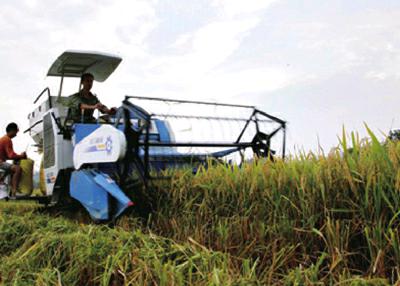Sweet Festival
2015-09-02
Local residents and tourists visit a melon garden in Hami, Xinjiang Uygur Autonomous Region, on the first day of the 12th Hami Melon Festival on July 20.
More than 150 breeds of Hami melons were displayed at the three-day event for visitors to taste for free.
Legal Aid System
Chinese legal experts met on July 22 to discuss improving the countrys legal aid system as the government plans legislation on the matter.
A draft of the legislation will be transferred to the State Council later this year, said Sun Jianying, Director of the Ministry of Justices Department of Legal Aid, at the seminar.
Nine million people have received legal assistance since the introduction of a regulation concerning the issue in 2003. With the public increasingly aware of their legal rights, more and more citizens are turning to legal aid, and the existing system has become inadequate.
It particularly needs to be improved during the stage of investigation, review and prosecution, according to Gu Yongzhong, a professor on criminal law study at China University of Political Science and Law in Beijing.
More than 70 percent of recipients of legal aid lack literacy, which means they need assistants to use plain language so they can understand their legal rights, said Tong Lihua, a legal aid expert with the All-China Lawyers Association.
Emission Reduction
All provincial regions in the Chinese mainland reached their targets for pollutant emission cut last year, the Ministry of Environmental Protection(MEP) said on July 22.
All of the eight centrally administered state-owned energy enterprises, including PetroChina, Sinopec, Huaneng, Datang, Huadian, China Power Investment Corp. and Shenhua, also reached their targets for annual cuts in emissions.
The evaluation included four indicators—chemical oxygen demand, ammonia nitrogen, sulfur dioxide and nitrogen oxide. Statistics showed that in Beijing the four indices dropped significantly, down 5.4 percent, 3.82 percent, 9.35 percent and 9.24 percent year on year, respectively.
Compared to 2010, the emission of all the four pollutants dropped around 10 percent, according to a report released by the MEP.
Maritime Services
China is drafting plans to protect the maritime resources on and around the Nansha Islands in the South China Sea and improve public services in the area, the State Oceanic Administration (SOA) said on July 21.
The plans include a maritime research center, a herbarium and database on sea creatures, environmental monitoring stations, and an emergency response center for oil spills.
Overfishing and pollution have caused the deterioration of precious marine resources, greatly threatening the areas ecology, according to the administration.
The seas around the Nansha Islands have witnessed frequent accidents due to the impacts of typhoons and unconventional security risks, but poor infrastructure has resulted in insufficient capacity of public services, the SOA said.
The SOA will establish a maritime monitoring center on the Nansha Islands and adjacent waters as part of a maritime monitoring and warning network to provide precise and timely ocean environmental data to surrounding countries and vessels passing through the South China Sea.
Government Accounts
Chinese central government departments on July 17 began to publish details about their expenditures in 2014, the fifth consecutive year of such disclosures and the first with details mandated by a new budget law.
The new law requires departments to publicize their spending of fiscal funds allocated by central authorities on procurement, organization operational costs and use of state-owned assets, along with previous details regarding spending on receptions, vehicles and overseas trips.
Administrative fees, such as fees on conferences and training, and government procurement information, have attracted much attention, most of which is negative. Publicizing the information is hoped to help increase public satisfaction with government activities.
Population Control
Beijing announced on July 17 a plan to cap its population at 21.77 million by the end of this year, part of an effort to cure“urban ills.”
The population of Beijing reached 21.516 million at the end of 2014. The large population has put pressure on water supply, air conditions, traffic and city ecology.
According to a guideline on integrated development of Beijing and neighboring Tianjin Municipality and Hebei Province approved by the Political Bureau of the Communist Party of China Central Committee in April, Beijing will limit its population to 23 million by 2020.
Solar Power in Tibet
With solar power plants aplenty and household solar facilities becoming increasingly commonplace, over 600,000 people in Tibet Autonomous Region use solar electricity, the local government said.
China has spent over 4 billion yuan($644 million) to increase solar power capacity to 200 megawatts in Tibet, which has the sunniest skies in China, according to the Tibet Regional Science and Technology Department.
The Xigaze sand Yangbajain photovoltaic plants have gone online in the last five years, with solar water heaters and 400,000 solar cookers given to Tibetan families.
The region also has many solarpowered phone base stations run by the countrys largest wireless service provider, China Mobile. About 79 percent of the companys 1,000 base stations in Tibet are driven by solar energy. Even the mobile signal and network coverage along the climbing routes on the north face of Mount Qomolangma, also known as Mount Everest in the West, come from solar power.
China has been raising the proportion of clean energy in its energy consumption. By 2014, solar power capacity had reached 28.05 gigawatts, 400 times the 2005 level. The figure is expected to reach around 100 gigawatts by 2020.
Reading Overnight
The newest, 24-hour branch of state-owned Cathay Bookshop opens on July 20 in Beijings Yanchi Tower, an ancient garrison dating back to 1420 and located just 2 km away from the Forbidden City—an ancient imperial palace in the citys center.
It is the third 24-hour bookstore in Beijing, after Sanlian Taofen Bookstore opened its first location last year and the second in April.
Hanging With Robots
A working staff displays how a robot does rescue work at RoboCup 2015 Ecosystem Summit, which kicked off in Hefei, Anhui Province, on July 21.
RoboCup is an international initiative established in 1997 to promote robotics and artificial intelligence research, education and applications through competition and other academic activities.
Water for Taiwan
A historic contract was signed on July 20 to supply the Taiwan islet of Kinmen with water from the coastal Chinese mainland province of Fujian, which is only miles away from the islet.
Costing 387.8 million yuan ($62.46 million), the deal was reached after 20 years of feasibility studies and negotiations.
The deal calls for a daily water supply of 34,000 cubic meters transported through a 27.56-km water conveyance line from the Jinjiang River to Kinmen.
Home Price Rise
Chinas real estate market continued to warm up in June, with new home prices in more cities increasing on a month-tomonth basis.
Of the 70 large and medium-sized cities surveyed in June, new home prices climbed in 27, up from the 20 in the previous month, while 34 reported monthon-month price declines, down from Mays 43, according to data released on July 18 by the National Bureau of Statistics (NBS).
For existing homes, 20 cities saw price declines on a monthly basis, while 42 cities posted gains.
According to NBS statistician Liu Jianwei, home sales in top-tier cities where demand is high saw strong growth, while in less developed second- and third-tier cities, both new and existing home sales either stayed flat or dropped, with a narrowed rate of decline.
Chinas housing market is still under correction, said Li Peijia, a researcher with the Institute of International Finance under the Bank of China.
BRICS Bank
The New Development Bank (NDB) of BRICS opened in Shanghai on July 21 to finance infrastructure projects, mainly those taking place within BRICS countries.
BRICS countries are the worlds major emerging economies: Brazil, Russia, India, China and South Africa. BRICS leaders signed an agreement to establish the bank during their sixth summit in Brazil in July 2014. The bank will start operations at the end of this year or early in 2016.
The first chair of the board of governors will be from Russia, the first chair of the directors from Brazil and the first president from India.
The NDB will have an initial authorized capital of $100 billion and initial subscribed capital of $50 billion equally shared among the five founders.
On the relations between the NDB and the Asian Infrastructure Investment Bank (AIIB), Chinese Finance Minister Lou Jiwei said both the NDB, initiated by the five members of BRICS, and the AIIB proposed by China, showed how emerging economies could improve global infrastructure and reform global economic governance. The two will complement each other, as they are different in membership and are growing in different directions. The global demand for infrastructure funding is huge, he said.
Hi-Tech Helper
A farmer uses machinery to harvest rice in Renshou Township, Jingan County of east Chinas Jiangxi Province, on July 23.
Green Efforts
On July 20, construction began on Chinas largest solar power tower plant in the northwestern province of Qinghai.
Occupying 2,550 hectares of the Gobi Desert in Golmud, the plant will have an installed capacity of 200 megawatts and has the capability to supply electricity to 1 million households, according to Qinghai SolarThermal Power Group.
Once operational, the plant will slash standard coal use by 4.26 million tons every year, reducing emissions of carbon dioxide and sulfur dioxide by 896,000 tons and 8,080 tons, respectively.
The plant will also be Chinas first large-scale solar power plant under commercial operation, said Yu Mingzhen, Deputy Director of Qinghai Provincial Development and Reform Commission, heralding the project a landmark in Chinas solar energy development.
China has been focusing on increasing its proportion of clean energy. By 2014, the countrys solar power capacity was 28.05 gigawatts, 400 times more than 2005, and there are plans to increase this to around 100 gigawatts by 2020.
E-Commerce Trial
A fork lift loads up goods to be exported in Fuyang International Logistics Park on July 22, becoming the first batch of goods that was granted customs clearance from the China (Hangzhou) Cross-Border E-Commerce Comprehensive Trial Zone in Hangzhou, Zhejiang Province.
Joining the Top
A total of 106 Chinese companies made this years Fortune Global 500 list, up from 100 firms in 2014, according to the annual ranking released on July 22.
Sinopec Group, Chinas top oil refiner, was the second largest company in the world this year by total revenue, up from the third place in 2014, according to the new list topped by U.S. retail giant Walmart.
PetroChina, the largest oil and gas producer in China, remained in fourth place this year, while the State Grid Corp., the largest electric utilities company, remained seventh.
The number of Chinese companies on the list trailed only the United States, which boasts 128 companies.
Foreign Investment
Foreign direct investment (FDI) into China continued rising in the first half of 2015.
A total of $68.41 billion in FDI was used in the first six months, a year-onyear increase of 8.3 percent, according to data from the Ministry of Commerce(MOFCOM).
“The growth rate expanded a lot from the 2.2-percent rate registered in the same period last year, thanks to MOFCOMs continued efforts in widening pilot reforms in free trade zones, fewer government restrictions and active promotion of opening up in certain industries and inland areas,” said Wang Shouwen, Vice Minister of Commerce.
The service industry absorbed the largest amount of FDI in the first six months, accounting for 63.5 percent of the total in the country, with a year-onyear increase of 23.6 percent.
On the other side of the equation, outbound direct investment (ODI) from the Chinese mainland increased sharply in the first half of 2015, thanks to reduced government restrictions.
Chinas non-financial ODI grew 29.2 percent in the first six months to $56 billion, according to MOFCOM data.
“We are very confident that China will accomplish or probably outperform the annual target of 10-percent ODI growth,” said Zhang Xiangchen, deputy international trade representative with the MOFCOM.
ODI in manufacturing jumped 63.1 percent to $5.09 billion.
China revised an ODI regulation last October, streamlining procedures and allowing domestic enterprises to invest in more sectors abroad.
“The government is trying to create an easier environment for enterprises to explore overseas markets,” said Zhang.
Belt and Road Benefits
Chinese companies signed 1,401 project contracts in countries along the Belt and Road in the first half of this year, nearly half of combined overseas contract value, official data revealed.
The contracts were worth $37.6 billion, up 16.7 percent year on year, and accounting for 43.3 percent of contracts in the period, according to data from MOFCOM.
The Belt and Road refer to the Silk Road Economic Belt and the 21st Century Maritime Silk Road, proposed by China in 2013 with the goal of boosting trade between Asia and Europe. The network passes through more than 60 countries and regions, with a total population of 4.4 billion.
Chinese companies signed overseas project contracts worth $86.7 billion in the first six months, representing an increase of 6.9 percent year on year, according to MOFCOM.
